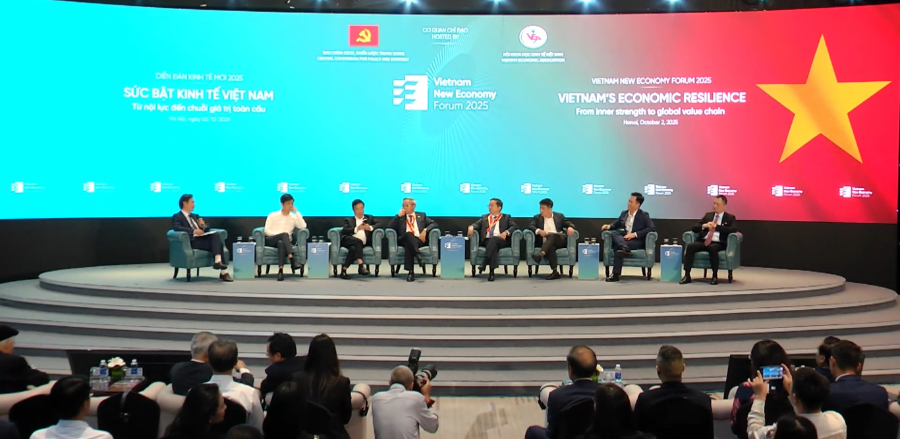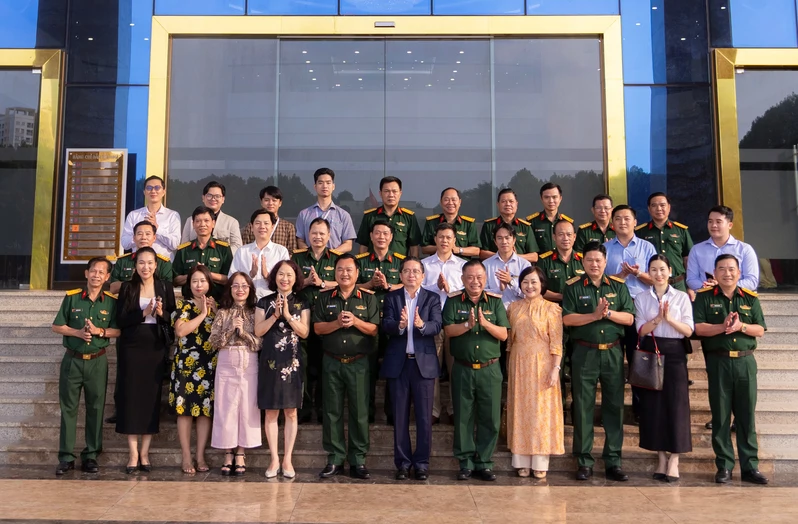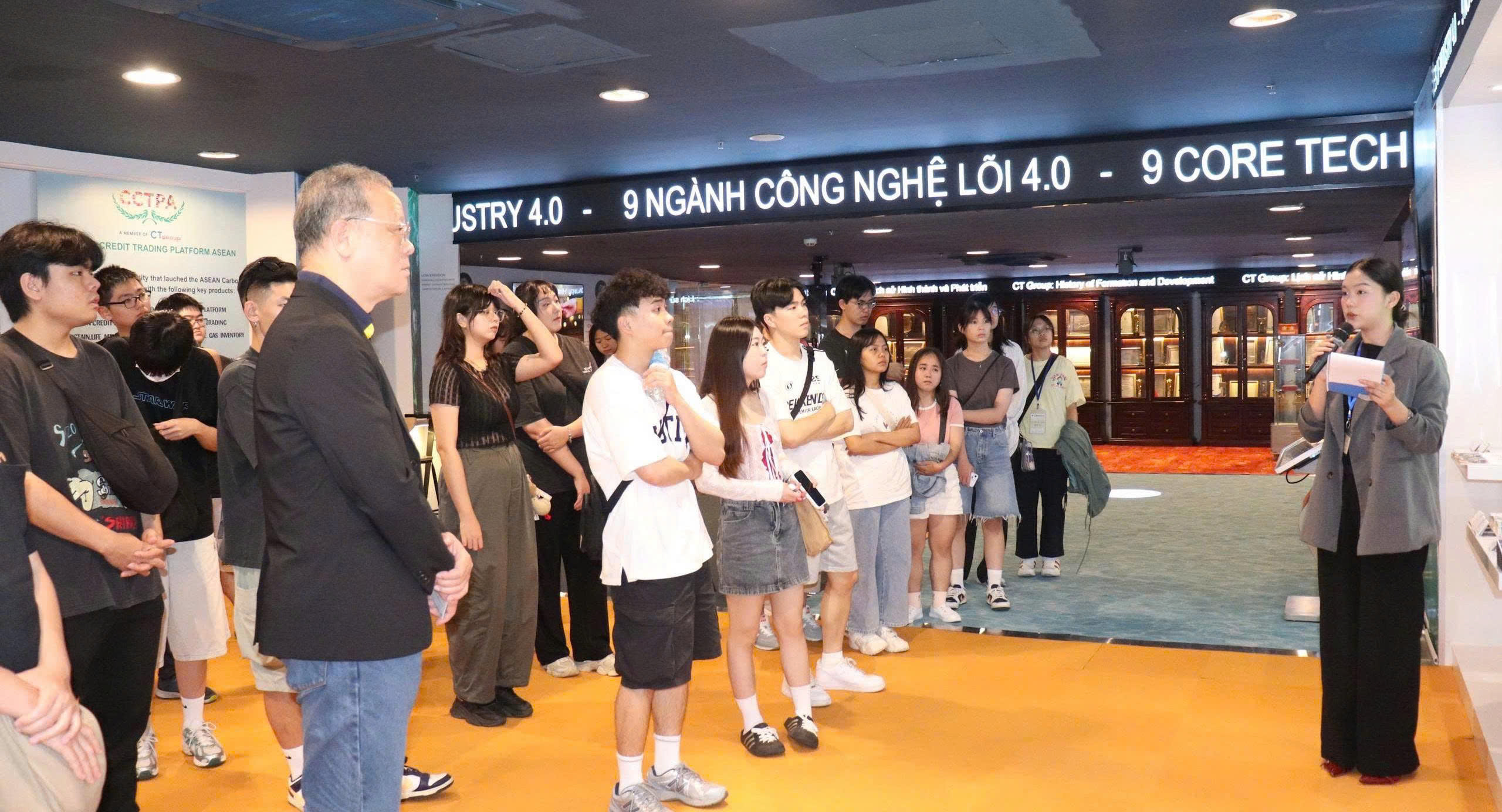To create new momentum in the coming period, Vietnam and its business community must proactively adopt new economic models, while effectively leveraging existing market and technology potential as well as innovation, thereby making significant contributions to national economic growth.

The discussion session on “Solutions to Strengthen Internal Capacity, Develop New Economic Models, and Enhance Position and Value in Global Supply Chains” held within the framework of the Vietnam New Economy Forum (VNEF) 2025.
On October 2, the third Vietnam New Economy Forum officially took place in Hanoi under the theme: “Vietnam’s Economic Momentum: From Internal Capacity to the Global Value Chain.”
The event was organized under the guidance of the Central Policy and Strategy Board, with coordinating units including the General Economic Department, the Institute for Policy and Strategy Research, the Vietnam Economic Science Association, and Vietnam Economic Times/VnEconomy.
During the discussion session on “Solutions to Strengthen Internal Capacity, Develop New Economic Models, and Enhance Position and Value in Global Supply Chains”, representatives from businesses offered a variety of proposals to answer the central question: “How can Vietnam better harness its internal resources while seizing opportunities to break through amid global economic uncertainty?”
NEW ECONOMIC MODELS LEVERAGING TECHNOLOGY FOR THE DEVELOPMENT MOMENTUM
Although Vietnam continues to face global economic headwinds ranging from inflation and geopolitical conflicts to supply chain disruptions and intense trade competition, the country and its business community still have significant opportunities for growth if they can harness new drivers of development effectively.
According to Tran Kim Chung, Chairman of CT Group, one strategic direction Vietnam should prioritize is developing the low-altitude economy- a model that has been rapidly advancing in countries such as China.
This new economic model focuses on the airspace 1,000-3,000 meters above ground, applying a range of low-altitude vehicles such as UAVs, air taxis, and light helicopters… to serve logistics, smart agriculture, tourism, surveillance, and rescue operations.
Mr. Chung emphasized that the model could be widely applied across sectors including construction, transportation, energy, security, agriculture, and tourism, while also enabling cross-sectoral integration to create entirely new forms of economic activity.
Significantly, the low-altitude economy also helps address key national challenges such as ensuring food security through precision agriculture, reducing urban congestion and pollution, and tackling climate change with advanced technologies.

Business representatives put forward solutions that Vietnam and its enterprises should adopt to contribute to growth. (Photo: Viet Dung)
“This model not only aligns with global technological development trends but also suits Vietnam’s current resources and conditions, as we are starting on equal footing with many other nations. It is a golden opportunity for Vietnam to create a leap forward in economic and sectoral growth,” Mr. Chung noted.
Beyond new economic models, business leaders agreed that technology and innovation are fundamental to strengthening internal capacity.
Ma Tuan Trong, CEO of Grab Vietnam, shared that in the digital transformation era, Vietnamese businesses must promote multi-stakeholder collaboration not only between enterprises but also between businesses and the State in order to co-develop innovation programs.
Most importantly, businesses must always put consumers at the center. Technology should not just be a race; it must answer the question: What do users need? Only then can businesses achieve sustainable growth through innovation,” Mr. Trong said.
Alongside the efforts of individual enterprises, the support and partnership of the Government play a crucial role in the process of national digital transformation and innovation.
In particular, the State needs to establish a safe testing environment for new ideas such as sandbox mechanisms so that small and medium-sized enterprises can confidently experiment, validate, and develop their own technology products… This serves as the foundation for fostering creativity and motivating Vietnamese businesses to compete and break through with confidence.
SHIFTING THE “OUTSOURCING” MINDSET, LEVERAGING DOMESTIC MARKET POTENTIAL
For long-term development goals, Vietnamese enterprises must undergo a fundamental shift in mindset, moving away from an “outsourcing” role to becoming true “owners” of products and intellectual value.
In technology, Nguyen Trung Chinh, Chairman of CMC Technology Group, urged businesses to master their products, assert creative capabilities, and bring their intellectual property to the global stage instead of stopping at subcontracting. He pointed to India as an example of a country that became a technology powerhouse by pursuing self-reliance and developing its own domestic tech products.
“This mindset change is not only necessary for technology but across all economic sectors in Vietnam. We must focus on owning products and creative value, thereby step by step elevating our position to be on par with global powers,” Mr. Chinh said.

According to experts, businesses need to change their development mindset and know how to take advantage of the available market potential. (Photo: Viet Dung)
In particular, as Vietnam accelerates economic growth while integrating more deeply into global value chains, domestic enterprises should place greater emphasis on fully tapping into the domestic market.
With a population of 100 million, rising incomes, and a modern distribution system, Vietnam’s domestic market is truly a “gold mine” if leveraged effectively.
Illustrating the potential of the domestic market, Dau Anh Tuan, Deputy Secretary General and Head of the Legal Department at the Vietnam Chamber of Commerce and Industry (VCCI), noted that while Vietnamese cinema was once completely overshadowed by foreign films, in recent years it has gradually asserted its position by winning over local audiences with high-quality productions made by Vietnamese companies.
With the right investment, a clear grasp of consumer demand, and a focus on enhancing creative value, Vietnamese enterprises are fully capable of conquering the domestic market. By turning demographic scale and consumer culture into drivers of sustainable development, they can also lay a critical foundation for other industries to follow suit, step by step building strong Vietnamese brands that not only serve the domestic market but also reach international audiences.
Despite heavy pressure from reciprocal tax policies and intense competition, Mr. Tuan believes Vietnamese businesses still hold a key advantage: their deep understanding of the domestic market, local consumers, and cultural context. This, he said, is the decisive factor that enables them to win over the domestic market through pricing, branding, and customer experience.
“Therefore, in the coming time, Vietnamese enterprises should boldly invest and tap more deeply into the domestic market, as it provides the firm foundation for expanding to the global stage,” Mr. Tuan emphasized.
Beyond exploring new growth models and spaces such as the low-altitude economy, the digital economy, and other emerging concepts, Vietnam requires stronger coordination between the State and the business community.
To make this a reality, Dr. Le Duy Binh, Director of Economica Vietnam, stressed that regulators and policymakers must introduce legal mechanisms and frameworks that not only meet governance requirements but also unlock and effectively mobilize resources.
Policies should be designed to encourage innovation, unleash the full productive potential of the economy, and ensure resource use and allocation follow a development-oriented approach.
“Most importantly, the State must also reinforce business confidence through concrete actions such as building a safe, transparent, and cost-effective business environment. Such an environment will encourage enterprises to embrace risk, invest boldly, and contribute more resources to the overall development of the economy,” Dr. Binh noted.
________________________
Follow CT Group on Facebook for the latest updates and news!







